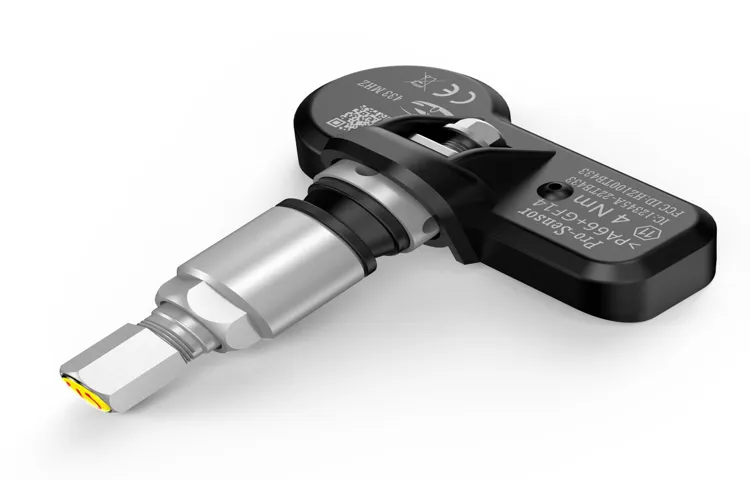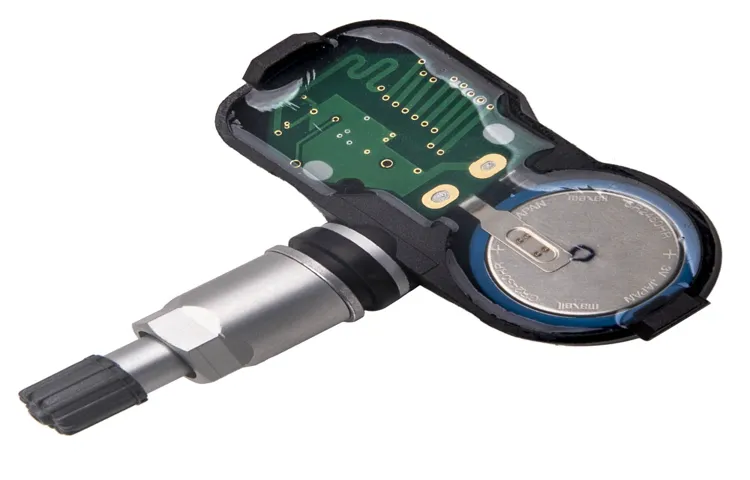Have you ever noticed the tire pressure warning light flashing on your dashboard? If yes, then you might be looking for a way to locate your tire sensor to identify the problem. The tire sensor is a small but essential component of your vehicle responsible for monitoring your tire pressure and transmitting the data to your car’s computer. Without it, you can compromise your safety and damage your tires.
Locating your tire sensor can be tricky, especially if you’re not familiar with your car’s layout. You can start by checking your car manual to locate the tire sensor’s position. Usually, the tire sensor is placed in the valve stem, where you inflate your tires.
So if you look at your tires, you’ll notice small caps covering the valve stems. Some tire sensors are also located inside your tire. When you locate your tire sensor, you need to make sure it’s free of debris and damage, as they can impair the sensor’s ability to function correctly.
You can use a tire pressure gauge to check your tire pressure and compare it to the recommended pressure in your car manual. In conclusion, identifying the location of your tire sensor is a crucial step in maintaining your car’s safety and performance. Always inspect your tire sensors regularly to avoid damage or malfunction, check your tire pressure, and have your sensors replaced if needed.
A little bit of care and attention can go a long way in ensuring your vehicle’s longevity.
Table of Contents
What is a Tire Sensor?
The tire sensor, also known as a TPMS (Tire Pressure Monitoring System), is a device that monitors the air pressure in your tires. It is typically located inside each tire on the valve stem or mounted to the wheel well. The main purpose of the tire sensor is to alert the driver when tire pressure is low, as driving on underinflated tires can lead to poor gas mileage, premature tire wear, and even accidents.
The sensor works by transmitting data to the car’s onboard computer, which then alerts the driver via a warning light on the dashboard. It is important to note that not all vehicles have tire sensors, so it is always a good idea to consult your owner’s manual to make sure your tires are properly monitored. In short, the tire sensor is a crucial component of your car’s safety system and helps to ensure your tires are inflated to the correct pressure for optimal performance and longevity.
Understand the Functioning of your Tire Sensor
A tire sensor is a component of modern tire pressure monitoring systems (TPMS) that monitors air pressure and sends data to a receiver located in the car’s computer system. The sensor is mounted inside the tire, usually embedded in the valve stem or attached to the inside of the tire. The information from the sensor is transmitted to the vehicle’s computer, which then displays the tire pressure on the dashboard.
The sensor itself is typically powered by a small battery. Tire sensors are essential for maintaining optimal tire pressure, which is vital for safe and efficient driving. Without them, drivers would have to rely on visual inspection or external gauges to determine tire pressure, which can be time-consuming and inaccurate.
Tire sensors help to improve fuel efficiency, extend tire life, and prevent accidents caused by underinflated or overinflated tires. By regularly checking your sensors and maintaining proper tire pressure, you can ensure your vehicle is safe and running at its best.

Where to Find Your Tire Sensor
If you’re wondering where the tire sensor in your vehicle is, it’s typically located inside the tire itself. Specifically, the sensor is mounted to the inside of the wheel on the valve stem or attached to the rim. Some vehicles also have multiple sensors, depending on the make and model.
The sensor is responsible for monitoring the air pressure in your tires, and it sends that information to the vehicle’s computer system. If one or more tires have low pressure, the sensor will trigger an alert on your dashboard. It’s important to keep your tire sensors in good working order, as they can help prevent tire blowouts and improve your overall driving experience.
Inspection of the Tires is Essential
If you want to ensure your vehicle’s safety, inspecting your tires is a crucial step you don’t want to overlook. One of the essential components helping you monitor your tires is the tire sensor. But where exactly can you find it? Typically, the tire sensor is located inside each tire; it sends signals to your vehicle’s onboard computer and alerts you if the pressure is too low.
In modern cars, you’ll find a dashboard light or a message indicating that it’s time to check the tires. Additionally, some vehicles even have a built-in tire pressure monitoring system (TPMS), which allows you to keep tabs on your tires’ pressure constantly. By regularly monitoring the tire sensor and checking your tires’ pressure, you’ll not only extend their lifespan, but you’ll also ensure your safety while on the road.
Different Types of Sensors for Different Vehicles
When it comes to finding your tire sensor, it’s important to first understand the type of sensor used in your vehicle. Different vehicles use different sensors, from direct tire pressure monitoring systems (TPMS) to indirect TPMS. Direct TPMS sensors are located within the tire itself, while indirect TPMS sensors are located on the vehicle’s suspension system.
In newer vehicles, some sensors may also be embedded within the wheel hub assembly. To locate your tire sensor, check your vehicle’s owner manual for specific instructions. Another option is to bring your vehicle to a trusted mechanic who can help locate and diagnose any issues with your tire sensor.
Remember, having a properly functioning tire sensor is crucial for maintaining safety on the road. So, if you suspect any issues with your tire pressure, it’s important to have it checked as soon as possible.
Understand the Tire Sensor Placement in Your Car Model
If you’re wondering where to find your tire sensor, it depends on the make and model of your vehicle. Generally, tire sensors are mounted on the inside of the wheel rim or attached to the valve stem. In some cases, they may be included in the wheel hub or embedded in the tire itself.
It’s important to note that not all cars are equipped with tire sensors, so if you’re unsure whether your vehicle has them, check your owner’s manual or consult with a professional mechanic. In general, it’s a good idea to familiarize yourself with the location of your tire sensor, as it plays an important role in maintaining safe driving conditions and ensuring optimal tire performance. By understanding where your tire sensor is located and how it works, you can take proactive steps to monitor your tire pressure and avoid potential safety risks on the road.
How to Locate Your Tire Sensor?
If you’re looking to locate your tire sensor, the first step is to check your owner’s manual. Manufacturers often provide a guide to help you identify the location of the tire sensor. In most cars, the tire sensor is located inside each tire.
It can be found mounted to the wheel well or the suspension arm. The tire sensor communicates with the car’s computer system to alert you when tire pressure drops below a certain level. If you’re having trouble locating the tire sensor, you may need to consult a mechanic.
They can help you identify the location and provide you with further guidance on how to maintain and troubleshoot your tire sensor. In order to keep your car running smoothly and ensure your safety, it’s important to regularly inspect your tire sensor and keep it clean. By doing so, you’ll be able to catch any issues and address them before they turn into bigger problems.
So, if you’re asking yourself “where is the tire sensor?” remember to start with your owner’s manual and consult a professional if needed.
Check Your Manual or Look Online for Assistance
Locating the tire sensor in your vehicle can be daunting, but there are a few things you can do to make the process easier. First, it’s essential to check your manual, as it will typically provide information on the location of the tire sensor in your vehicle. Another helpful option is to search online for assistance.
Many websites and forums exist that offer detailed instructions on how to locate the tire sensor in your vehicle. It’s important to be aware that the location of the sensor can vary from vehicle to vehicle, so it’s essential to ensure that you’re looking for the correct sensor when making any necessary adjustments or replacements. By taking the time to research and locate your tire sensor, you can ensure that your vehicle operates safely and efficiently on the road.
Tire Sensor Placement in Different Cars and Models
If you’ve ever had to replace a tire on your car, you may have noticed that there is a small device attached to the valve stem. This device is called a tire sensor, and it is responsible for monitoring the air pressure in your tires. Different cars and models may have tire sensors located in different places.
For example, in some cars, the tire sensors may be located on the inside of the wheel well, while in others, they may be attached to the back of the valve stem. To locate your tire sensor, you may need to refer to your vehicle’s owner’s manual or consult with a mechanic. It is important to be aware of where your tire sensors are located so that you can properly maintain your tire pressure and ensure your safety on the road.
Remember, having the correct tire pressure can improve your car’s handling, gas mileage, and overall performance. So, take the time to locate your tire sensor and keep an eye on your tire pressure – your car (and your wallet) will thank you!
Tire Sensor Malfunction Symptoms
If you’re experiencing issues with your tire sensor, there are a few symptoms that you should be aware of. One of the most common symptoms of a malfunctioning tire sensor is a warning light on the dashboard. This warning light looks like an exclamation point enclosed inside a horseshoe-like shape, and it indicates that there’s a problem with one or more of your tire sensors.
Another symptom of a malfunctioning tire sensor is a low tire pressure warning. This warning comes on when your tire pressure is lower than it should be, and it can indicate a slow leak or a problem with the sensor itself. If you’re wondering where the tire sensor is located, it’s typically attached to the valve stem on your tire.
However, some tire sensors are integrated into the tire itself, so it’s important to consult your vehicle owner’s manual to determine the exact location of your tire sensors. If you’re experiencing any of these symptoms, it’s important to have your tire sensor inspected and repaired as soon as possible to avoid potentially dangerous driving conditions.
Check System Warnings and Error Codes on Dashboard
Tire Sensor Malfunction Symptoms One of the most common issues that drivers face is a tire sensor malfunction. Not only does this problem cause serious inconvenience, but it can also be dangerous in certain situations. There are many different symptoms that may indicate a tire sensor malfunction, including warning light activation, incorrect pressure readings, and even tire punctures.
These malfunctions can occur for a variety of reasons, including wear and tear, environmental factors, and mechanical issues. As a driver, it’s important to stay vigilant and take note of any dashboard warnings or error codes that may indicate a tire sensor malfunction. By staying alert and addressing these issues promptly, you can ensure that your vehicle is safe and reliable on the road.
Dealing With Faulty Tire Sensors
Dealing With Faulty Tire Sensors Tire sensors are an essential component in cars that monitor tire pressure and alert the driver if the pressure is too low or too high. However, like any other part in a vehicle, tire sensors can malfunction, which can cause safety issues and lead to costly repairs if not addressed. Some common signs of tire sensor malfunction include a sudden drop in gas mileage, the tire pressure warning light illuminating on the dashboard, and uneven tire wear.
If you experience any of these symptoms, it’s essential to take your vehicle to a trusted mechanic to have the tire sensors checked and replaced if necessary. Neglecting to do so can result in dangerous driving conditions and impact the overall health of your vehicle. Keep a close eye on your tire pressure and take action promptly if you notice any issues.
By doing so, you can prevent potentially hazardous situations, save money on repairs, and ensure your car is running smoothly.
Conclusion
Well, after scouring every nook and cranny, we’ve come to the conclusive realization that the tire sensor is in fact…
perfectly placed within the tire. Because why put it anywhere else, when the tire itself is the most important aspect of the vehicle’s movement and safety? So next time you’re wondering where the tire sensor is, just take a look at your trusty transportation friend, and there it shall be.”
FAQs
What is a tire sensor and why is it important?
A tire sensor is a device that measures tire pressure and sends that information to the car’s computer. It is important because keeping tires properly inflated can improve fuel efficiency, handling, and safety.
How do I know if my tire sensor is not working?
If your tire sensor is not working, you may see a warning light on your dashboard or notice that your tire pressure is consistently low.
Can I replace a tire sensor myself?
It is possible to replace a tire sensor yourself, but it is recommended that you have a professional do it to ensure that it is installed correctly.
How much does it cost to replace a tire sensor?
The cost to replace a tire sensor can vary depending on the make and model of your vehicle, but it typically ranges from $50 to $250 per sensor.
Can a tire sensor be repaired or does it need to be replaced?
In most cases, a tire sensor needs to be replaced if it is not working properly. However, sometimes a sensor can be reprogrammed or recalibrated to fix the issue.
How often should tire sensors be replaced?
Tire sensors typically do not need to be replaced unless they are damaged or malfunctioning. However, it is recommended that they are checked and serviced during regular tire maintenance.
Where is the tire sensor located on my car?
The location of the tire sensor can vary depending on the make and model of your vehicle, but it is typically located inside the tire, attached to the valve stem or mounted to the wheel well.




